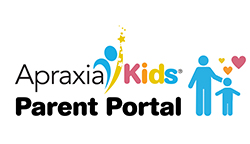Childhood apraxia of speech (CAS) is a motor speech disorder that affects a child’s ability to plan the movements needed for talking. Motor learning for speech occurs in a very similar way to the motor learning required for tying shoelaces, shooting a basketball, or hitting a golf ball with a golf club. The principles and theories that help us understand this learning process are called “Principles of Motor Learning”, and should be the guiding factor in speech therapy for children with CAS. The key factors required for successful speech therapy for CAS include the following:
FOCUS ON SPEECH SEQUENCES
The primary focus of speech therapy for children with CAS is the movement from one sound to another, one syllable to another, and one word to another in a smooth, natural way. Speech targets (words or phrases to work on) should be meaningful, functional, and motivating for the child (as well as practical). Parental/caregiver input is very valuable to help the SLP come up with just the right targets. Consonants (C) and vowels (V) are chosen in just the right syllable shapes (CV (ma), CVC dad), VC (up) V.CV (I do), etc.) to best meet each child where they are at, and then build to more complex syllable/phrase/sentence structures from there.
PRACTICE AND REPETITION – WITH SPEECH
Speech targets (words, phrases, sentences) should be practiced with many repetitions, and with a great degree of frequency (practicing often) and intensity (practicing a lot). Individual therapy should be scheduled in frequent, short and intensive sessions. Frequent (2 to 5 sessions per week); short (20-30 minutes); intensive (75-100 or more practice trials) initially.
USE OF MULTI-SENSORY CUEING
Sometimes children require extra ‘help’ in controlling the movements of speech. The extra ‘help’ often comes in the form of visual cues (i.e., SLP will point to areas on the face or neck to help ‘remind’ the child where to produce the sound), tactile cues (SLP will use fingers to touch the child’s face, or neck, to help the child know what the movement feels like), and verbal cues (SLP relies on verbal explanations of the movements to help the child understand what to do). Regardless of the types of cues a child needs, cueing should be reduced and eliminated as soon as possible to help the child become an independent communicator.
FEEDBACK
Children need to know whether their speech attempts are correct or incorrect. SLPs should carefully weigh how much help to give the child to let them know how they can form the sounds or syllables. This includes telling the child specifically about their movement, called knowledge of performance (e.g., “you made your lips pop”). It also includes telling the child how they did, or knowledge of results (e.g., “You did it!” or “Try again”). Trained speech therapists will know just how much feedback to give a child, and what it should sound like, as well as when to give it.
USE OF RHYTHM
Many children with CAS struggle with the ‘prosody’ of speech, which is the rate, intonation (sing-song quality, such as voice going up when a question is asked), and stress of syllables in words or the stress of words in a sentence that change the meaning. Clapping or tapping for each syllable/word can help children learn appropriate stress of words. The prosody of speech should be addressed early in therapy.
NEED FOR SUCCESS
Children with CAS are typically aware of their difficulties and their strengths, therefore it is important that children experience success in talking, so that they understand the power behind communication and are less likely to withdraw from communication opportunities. The growth in confidence (especially at the beginning of therapy), will help motivate them to keep practicing. Success breeds success, and confidence breeds confidence!
In addition, therapy approaches should include activities that:
- are dynamic. Dynamic therapy uses visual, auditory and/or touch cues that are gradually faded over time which can help the child control his speech on his own.
- focus on motor learning for speech movements that change from simple to complex.
- use the vowels, consonants and syllable shapes already in the child’s inventory of sounds and syllable shapes.
- treat the whole child by addressing all areas of need or making appropriate referrals to other professionals.
- may include sign language, natural gestures or picture boards. These encourage children to communicate and they support communication.
- monitor and treat language problems, as needed.
- include movement within speech therapy. Whole body movement seems to help with speech.
- uses words or phrases that are functional, meaningful and powerful for the child.
- are motivating and encourage the child’s attention.
Therapy should be provided by an ASHA-certified speech-language pathologist (“CCC-SLP”) with training and experience treating CAS. The therapist must know how to incorporate the principles of motor learning in order to provide appropriate treatment. Other professionals, such as an SLPA (SLP Assistant), must be supervised by the certified and knowledgeable SLP who meets weekly to review progress.
Karen Ruehle-Kumar, M.A., CCC-SLP and Stacey Mecham, MSLP, CCC-SLP
November 2021
